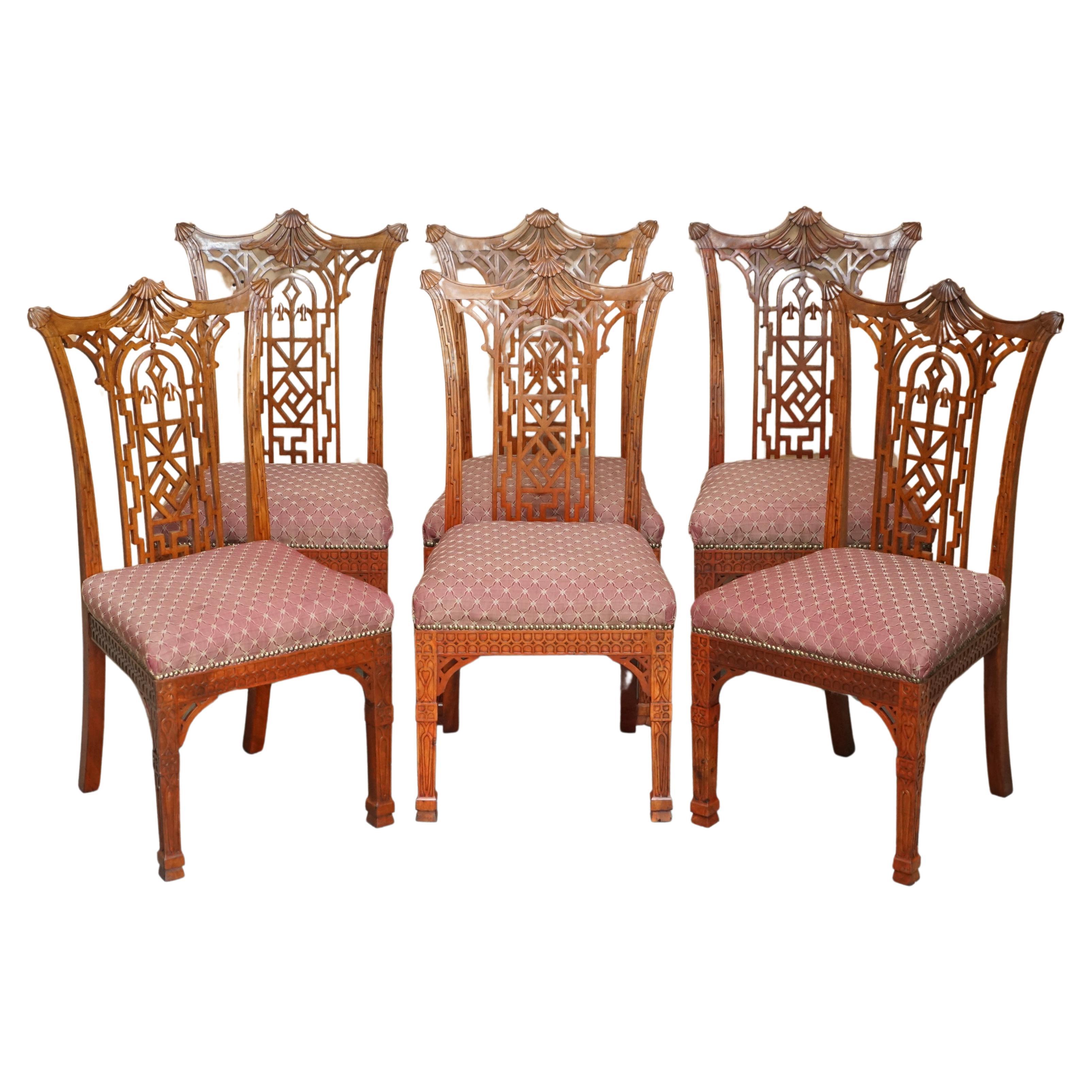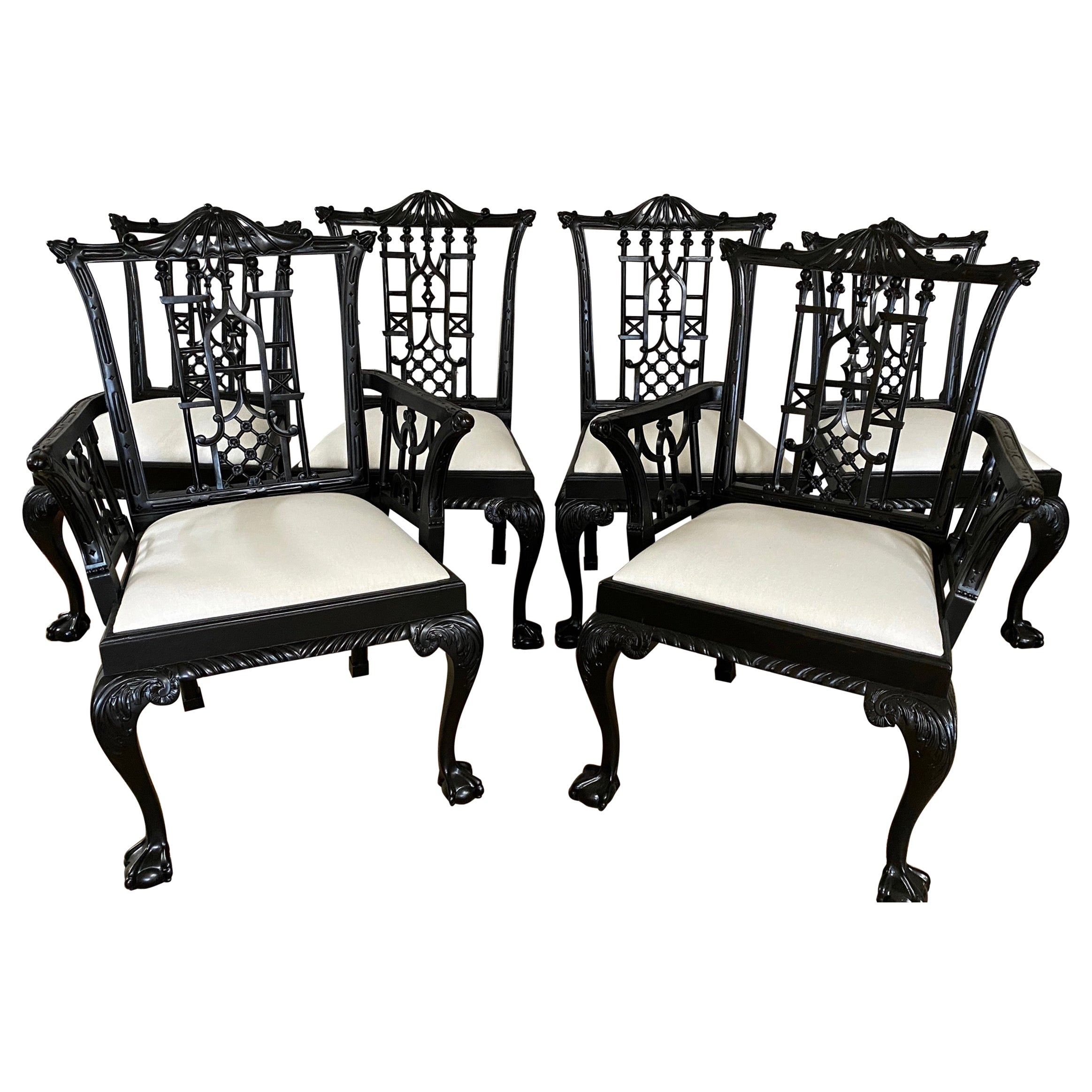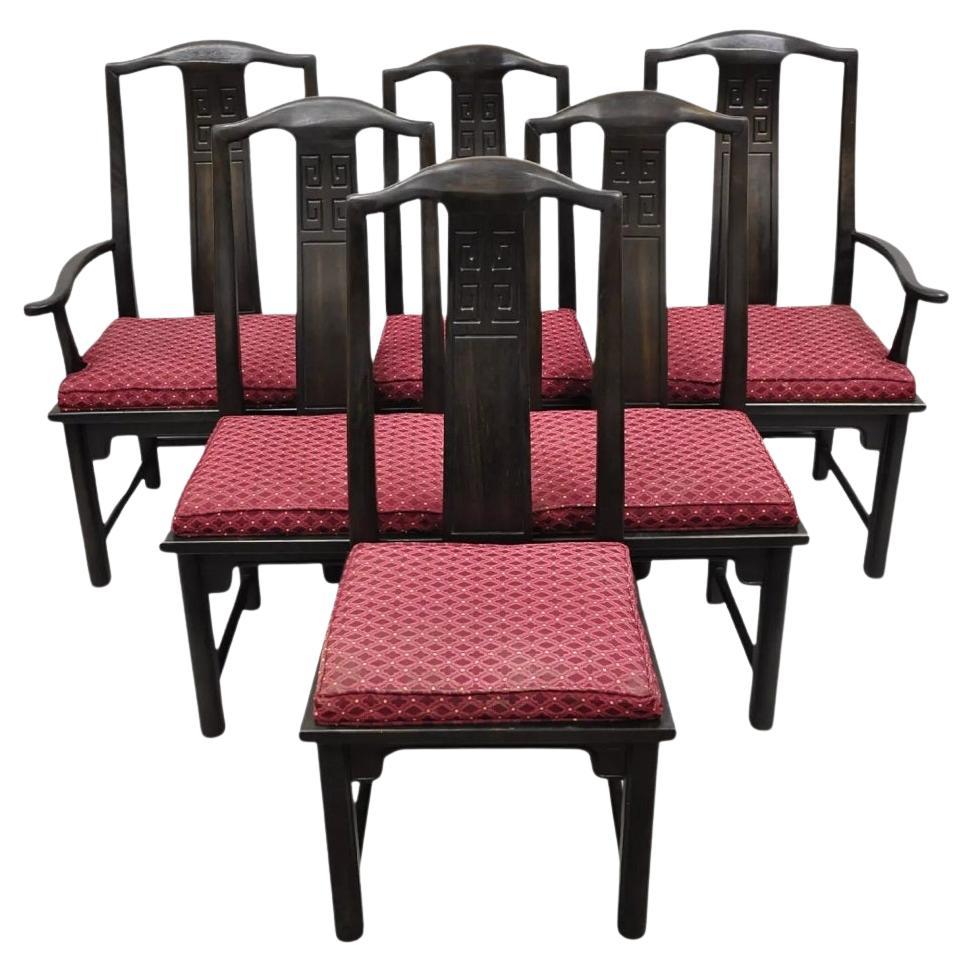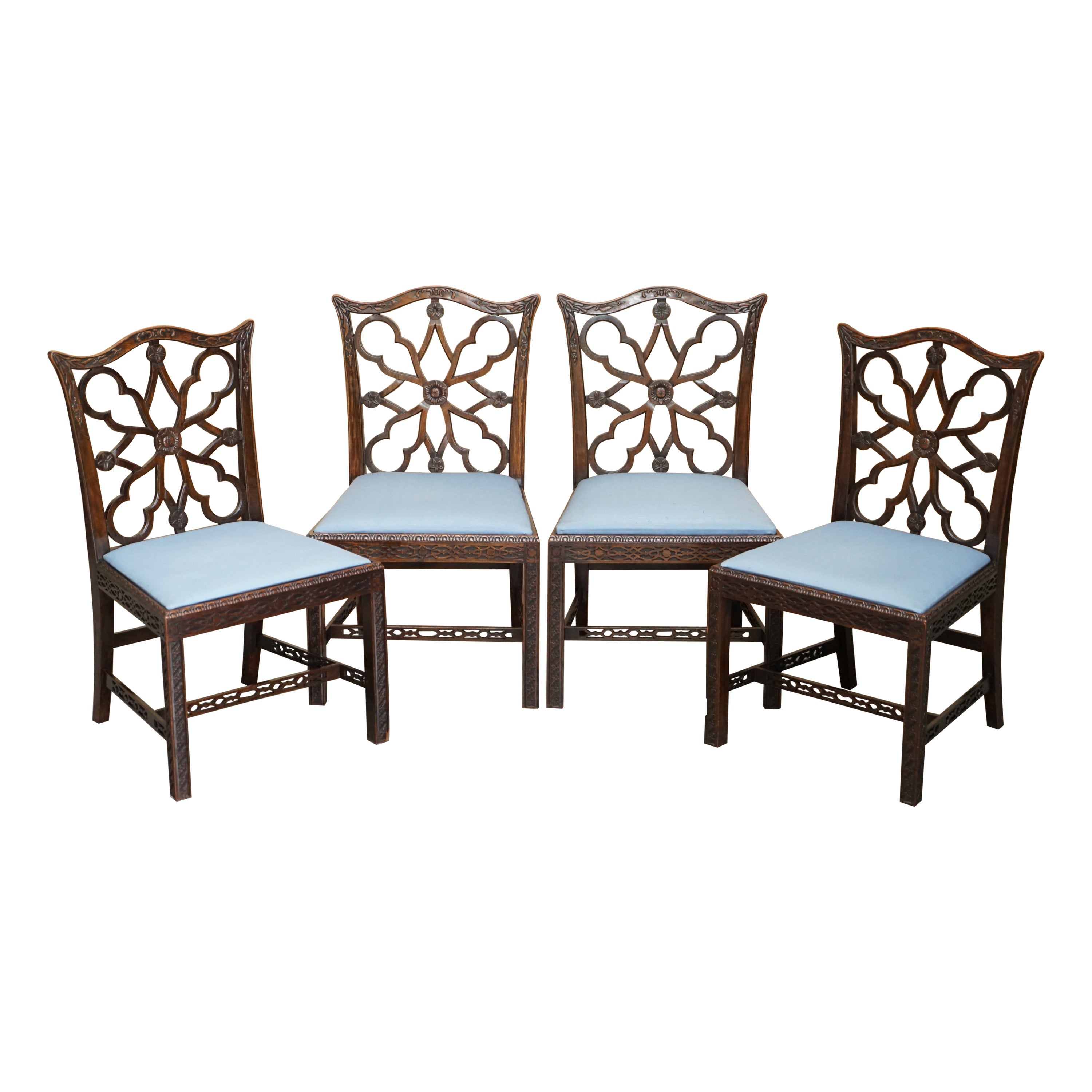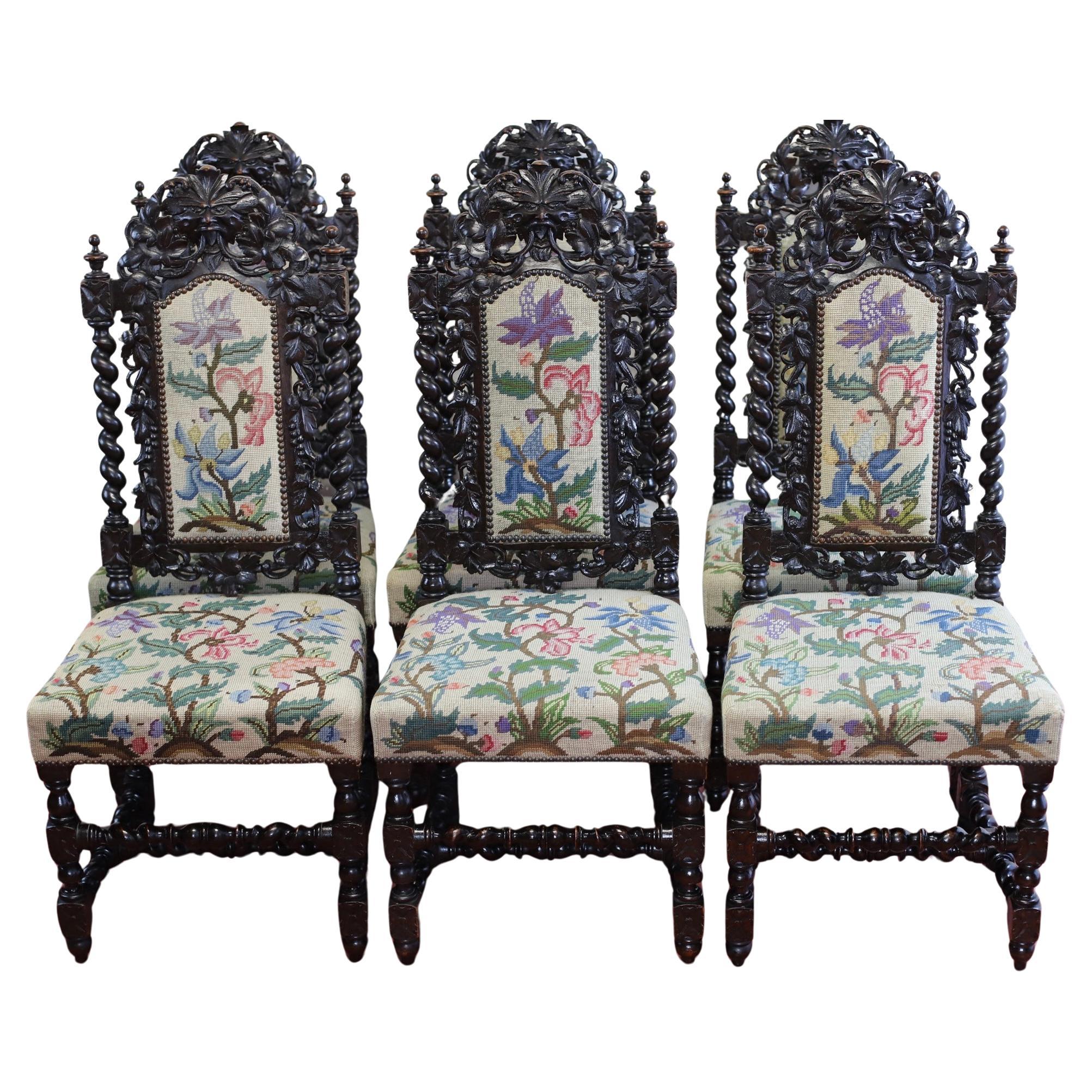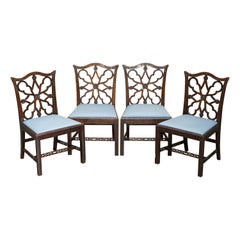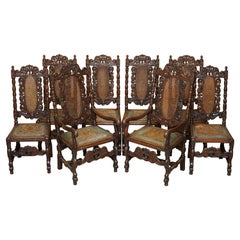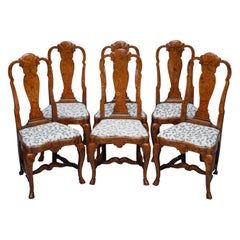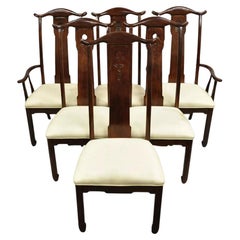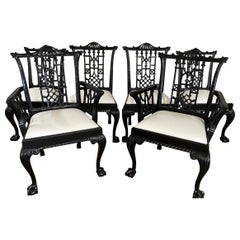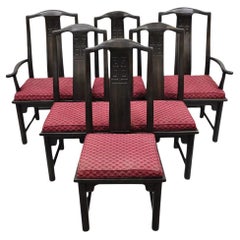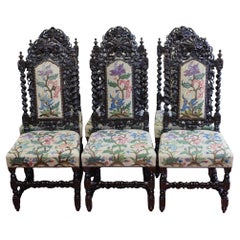Items Similar to Six Imporatant George III 1760 Thomas Chippendale Chinese Pagoda Dining Chairs
Want more images or videos?
Request additional images or videos from the seller
1 of 21
Six Imporatant George III 1760 Thomas Chippendale Chinese Pagoda Dining Chairs
$144,523.69per set
$240,872.81per set40% Off
£105,000per set
£175,000per set40% Off
€123,076.95per set
€205,128.25per set40% Off
CA$197,302.29per set
CA$328,837.15per set40% Off
A$219,490.72per set
A$365,817.87per set40% Off
CHF 115,059.79per set
CHF 191,766.31per set40% Off
MX$2,682,123.03per set
MX$4,470,205.05per set40% Off
NOK 1,465,142.83per set
NOK 2,441,904.71per set40% Off
SEK 1,379,229.28per set
SEK 2,298,715.46per set40% Off
DKK 918,722.62per set
DKK 1,531,204.36per set40% Off
Shipping
Retrieving quote...The 1stDibs Promise:
Authenticity Guarantee,
Money-Back Guarantee,
24-Hour Cancellation
About the Item
We are delighted to offer this important suite of museum quality, George III circa 1760-1765, Thomas Chippendale Chinese Pagoda top dining chairs with the original embroidered seat pads
Where to begin, if you’re looking at this listing then the chances are you know exactly how significant this suite is. Thomas Chippendale was simply put, the most important furniture designer in history.
A similar suite of twelve chairs with one reproduction that were attributed to Chippendale and of the same Georgian period sold at christies three and a half years ago for a little over £400,000, they weren’t as close to the originals as these examples
The chairs are of the period, with the correct back carving and pagoda tops, the timber is the right age, they are the finest example available anywhere in the world today.
I was tempted to have the chair seats reupholstered in a nice period damask however when a friend and the finest restorer I have ever met cast his eyes over them he informed me the embroidery is very very fine and it would be a crime to remove them
The suite has been sympathetically restored to include a clean and French polished, all the frames have been checked and secured if required, these are perfectly usable examples
Literature
Two chairs illustrated in Tabellenbuch Holztechnik, Hamburg, 2013, p. 271.
Exhibited
Ten chairs on loan to Birmingham Museums circa 1985-2010 and exhibited at Aston Hall, Birmingham, where photographed in situ..
Dimensions
Height:- 103cm
Width:- 54cm
Depth:- 53.5cm
Please note all measurements are taken at the widest point,
Lot Essay
These chairs are closely related to those in two recognised Chippendale commissions: Sir Gilbert Heathcote (d. 1785), 3rd Baronet for Normanton Hall, Rutland and William Crichton-Dalrymple, 5th Earl of Dumfries (4th Earl of Stair, 1699-1768) for Dumfries House, Ayrshire.
THE RELATED CHAIRS
The chairs are of identical decoration to the set of two armchairs and ten single chairs, circa 1765, formerly at Normanton Hall (1). In 1759, Sir Gilbert Heathcote (d. 1785), 3rd Baronet, succeeded to the vast inheritance established by his grandfather, also Gilbert, 1st Baronet (1652-1733), who was reputed to be ‘the richest commoner in England’ (2). The 3rd Baronet employed both Chippendale Senior and his son, Chippendale Junior, in the furnishing of his Palladian mansion, Normanton Hall in Rutland, and his London houses, 29 Grosvenor Square, London and Browne's House at North End, Fulham. Surviving Chippendale accounts, although incomplete, show that the firm was working periodically for members of the Heathcote family from 1768 to 1821. Most of the furniture listed in these accounts was intended for Browne’s House, although after 1798 when the family relinquished this residence some of the furniture was moved to Normanton Hall. The latter was sold in 1924, and any furniture not included in the Normanton Hall sale was taken to the Earl of Ancaster’s seat at Grimsthorpe Castle, Lincolnshire. Chippendale’s earliest invoice for Sir Gilbert Heathcote records the acquisition in 1768 of ‘6 India Back and arm chairs Japand to imitate the Bamboe’, signifying how the family embraced the highly fashionable chinoiserie taste. Although the Normanton chairs cannot be conclusively identified in the extant Chippendale accounts, their form and ornamentation led Christopher Gilbert to suggest that they were possibly by Chippendale (3).
The set of four mahogany chairs at Dumfries House have nearly-identical pagoda-form cresting rails and identical terminals but differ in the arrangement of the 'Chinese' paling in the backs and side panels. Although no documentary evidence for the Dumfries chairs survives, in their execution and sophisticated carving of the toprails, they are extremely close to Chippendale’s hand.
Another near-set of closely related chairs is at Saltram House, Devon, where Chippendale worked between 1771-2; these dates are based on payments in John Parker's cash account book, and probably do not reflect a true picture of the entire commission as Parker often paid tradesmen by banker's draft (4). Comprising two armchairs and seven single chairs, this set, circa 1765, is made of padouk, and has been described by the National Trust as ‘Chinese Export’ (5). The set was returned to Saltram in 1951 having been accepted by H.M. Treasury in lieu of full payment of Death Duty from the Executors of Edmund Robert Parker, 4th Earl of Morley (1877-1951). Some of the chairs are currently on display in ‘The Chinese Chippendale Bedroom’.
A further set of four padouk chairs of the Saltram pattern was almost certainly at Kenwood House, London; some of these are recorded in 18th century inventories drawn up by Lord Mansfield. This set was removed to Scone Palace, Perth, prior to the auction at Kenwood in 1922, and subsequently sold from ‘Scone Palace and Blairquhan: The Selected Contents of Two Great Scottish Houses’, Christie’s, London, 24 May 2007, lot 298.
Another pair of padouk chairs of this model sold ‘The Collection of Peggy and David Rockefeller’, Christie’s, New York, 10 May 2018, lot 647 ($193,750 inc. premium).
THE DESIGN
Conceived in the Chinese manner expounded by William and John Halfpenny in Rural Architecture in the Chinese Taste (1752), and Sir William Chambers in his Designs of Chinese Buildings, Furniture, Dresses, Machines and Utensils (1757), the pattern for this set of ‘Pagoda’ chairs relates to nine designs for ‘Chinese Chairs’ in the 1st edition of Chippendale’s Director (1754); the cabinet-maker describes these designs thus:
Plates XXIII, XXIV and XXV are nine Chairs in the present Chinese manner, which I hope will improve that taste, or manner of work; it having yet never arrived to any perfection; doubtless it might be lost without feeling its beauty: as it admits of the greatest variety, I think it the most useful of any other. The sizes are all specified on the designs. The three last (No. XXV.) I hope will be well received, as there has been none like them yet made.
The Georgian period witnessed the proliferation of such railed and pagoda-crested chairs in both the ‘picturesque’ Chinese tea pavilions of landscaped parks as well as in fashionable apartments hung with ‘India’ paper. The geometric ‘Chinese’ feet of these chairs are also found on a set of pedestals, 1774, originally japanned green and gold, supplied to Harewood House, and also on a bureau dressing table from Paxton House, Berwickshire (6).
AYKLEY HEADS HOUSE, CO. DURHAM
The Dixon and Johnson families were united in 1749 by the marriage of Christopher Johnson (1718-87) and Tabitha Dixon, youngest daughter of George Dixon of Aykley Heads, and heiress to her brother John. Thus, the Aykley Heads estate passed through the female line to Tabitha’s son, Francis Johnson (1757-1851), and subsequently to his son, Francis Dixon Johnson (1803-1867); in 1929, the Dixon-Johnson family moved to Middle Ord, Northumberland. The descent of the family name has taken both forms, as Johnson and Dixon-Johnson, the latter being formally taken in the later nineteenth century (although still appearing in unhyphenated form). As well as the legal profession and land in Co. Durham, the family acquired coal-mining interests.
(1) C. Gilbert, The Life and Work of Thomas Chippendale, Leeds, 1978, vol. II, p. 101, fig. 167.
(2) Ibid., vol. I, p. 248.
(3) Ibid., p. 249.
(4) Ibid., p. 257.
(5) C. Johnson, Saltram: National Trust Guide Book, revised 2005, p. 28; NT 871346.1-5 (single chairs); NT 871346.6-7 (armchairs).
(6) Gilbert, op. cit., vol. II, p. 208, fig. 380; p. 228, fig. 415. The Paxton bureau dressing table sold, Christie’s, London, 14 May 2003, lot 140 (£77,675 inc. premium), and later, Sotheby’s, London, 10 November 2015, lot 123.
This item is available for collection from our Pulborough warehouses RH20 1DF.
CONDITION
Please view the very detailed pictures as they form part of the description pertaining to the condition.
Please note vintage period and original items such as leather seating will always have natural patina in the form of creasing and wear, we recommend annual waxing to ensure no moisture is lost, also hand dyed leather is not recommended to sit in direct sunlight for prolonged periods of time as it will dry out and fade.
- Creator:Thomas Chippendale (Cabinetmaker)
- Dimensions:Height: 40.56 in (103 cm)Width: 21.26 in (54 cm)Depth: 21.07 in (53.5 cm)
- Sold As:Set of 6
- Style:George III (Of the Period)
- Materials and Techniques:
- Place of Origin:
- Period:1760-1769
- Date of Manufacture:1760
- Condition:Refinished. Wear consistent with age and use. Minor fading.
- Seller Location:West Sussex, GB
- Reference Number:1stDibs: LU2823326673332
About the Seller
4.7
Platinum Seller
Premium sellers with a 4.7+ rating and 24-hour response times
Established in 2012
1stDibs seller since 2017
1,995 sales on 1stDibs
Typical response time: <1 hour
- ShippingRetrieving quote...Shipping from: West Sussex, United Kingdom
- Return Policy
Authenticity Guarantee
In the unlikely event there’s an issue with an item’s authenticity, contact us within 1 year for a full refund. DetailsMoney-Back Guarantee
If your item is not as described, is damaged in transit, or does not arrive, contact us within 7 days for a full refund. Details24-Hour Cancellation
You have a 24-hour grace period in which to reconsider your purchase, with no questions asked.Vetted Professional Sellers
Our world-class sellers must adhere to strict standards for service and quality, maintaining the integrity of our listings.Price-Match Guarantee
If you find that a seller listed the same item for a lower price elsewhere, we’ll match it.Trusted Global Delivery
Our best-in-class carrier network provides specialized shipping options worldwide, including custom delivery.More From This Seller
View AllSIX EXQUISITE ViNTAGE THOMAS CHIPPENDALE STYLE CHINESE PAGODA TOP DINING CHAIRS
By Thomas Chippendale
Located in West Sussex, Pulborough
Royal House Antiques
We are delighted to offer this stunning suite of museum quality, George III style Thomas Chippendale Chinese Pagoda to...
Category
Vintage 1940s English George III Dining Room Chairs
Materials
Upholstery, Hardwood, Mahogany
FOUR ANTIQUE COLONIAL THOMAS CHIPPENDALE HARDWOOD FRET WORK CARVED DiNING CHAIRS
By Thomas Chippendale
Located in West Sussex, Pulborough
Royal House Antiques
We are delighted to offer this important suite of museum quality, antique Colonial Rosewood Thomas Chippendale, fret work carved dining chairs
Please note the delivery fee listed is just a guide and covers London only for the UK and local Europe for the rest of the world, if you are outside of this area please send me your address and I will provide you with an accurate quote
Where to begin, if you’re looking at this listing then the chances are you know exactly how significant this suite is, Thomas Chippendale was simply put, the most important furniture designer in history, these chairs are the only Colonial examples I have ever seen and in Rosewood no less, they weigh roughly three times more than a standard dining chair of the same style and size, they are very substantial
The chairs are late 19th century circa 1880-1900, they are of course based on the original 18th century examples, the carving is exquisitely executed and the chairs look sophisticated and elegant from all angles
The suite has been sympathetically restored to include a deep clean, hand condition wax and hand polish, the seat covers have been left as they are, they are ok, I can have them reupholstered for the cost price to anything the new owners wish
Literature
Two chairs illustrated in Tabellenbuch Holztechnik, Hamburg, 2013, p. 271.
Exhibited
Ten chairs on loan to Birmingham Museums circa 1985-2010 and exhibited at Aston Hall, Birmingham, where photographed in situ..
Dimensions
Height:- 93cm
Width:- 56cm
Depth:- 53cm
Seat height:- 47cm
Please note all measurements are taken at the widest point.
Lot Essay
These chairs are closely related to those in two recognised Chippendale commissions: Sir Gilbert Heathcote (d. 1785), 3rd Baronet for Normanton Hall, Rutland and William Crichton-Dalrymple, 5th Earl of Dumfries (4th Earl of Stair, 1699-1768) for Dumfries House, Ayrshire.
THE RELATED CHAIRS
The chairs are of identical decoration to the set of two armchairs and ten single chairs, circa 1765, formerly at Normanton Hall (1). In 1759, Sir Gilbert Heathcote (d. 1785), 3rd Baronet, succeeded to the vast inheritance established by his grandfather, also Gilbert, 1st Baronet (1652-1733), who was reputed to be ‘the richest commoner in England’ (2). The 3rd Baronet employed both Chippendale Senior and his son, Chippendale Junior, in the furnishing of his Palladian mansion, Normanton Hall in Rutland, and his London houses, 29 Grosvenor Square, London and Browne's House at North End, Fulham. Surviving Chippendale accounts, although incomplete, show that the firm was working periodically for members of the Heathcote family from 1768 to 1821. Most of the furniture listed in these accounts was intended for Browne’s House, although after 1798 when the family relinquished this residence some of the furniture was moved to Normanton Hall. The latter was sold in 1924, and any furniture not included in the Normanton Hall sale was taken to the Earl of Ancaster’s seat at Grimsthorpe Castle, Lincolnshire. Chippendale’s earliest invoice for Sir Gilbert Heathcote records the acquisition in 1768 of ‘6 India Back and arm chairs Japand to imitate the Bamboe’, signifying how the family embraced the highly fashionable chinoiserie taste. Although the Normanton chairs cannot be conclusively identified in the extant Chippendale accounts, their form and ornamentation led Christopher Gilbert to suggest that they were possibly by Chippendale (3).
The set of four mahogany chairs at Dumfries House have nearly-identical pagoda-form cresting rails and identical terminals but differ in the arrangement of the 'Chinese' paling in the backs and side panels. Although no documentary evidence for the Dumfries chairs survives, in their execution and sophisticated carving of the toprails, they are extremely close to Chippendale’s hand.
Another near-set of closely related chairs is at Saltram House, Devon, where Chippendale worked between 1771-2; these dates are based on payments in John Parker's cash account book, and probably do not reflect a true picture of the entire commission as Parker often paid tradesmen by banker's draft (4). Comprising two armchairs and seven single chairs, this set, circa 1765, is made of padouk, and has been described by the National Trust as ‘Chinese Export’ (5). The set was returned to Saltram in 1951 having been accepted by H.M. Treasury in lieu of full payment of Death Duty from the Executors of Edmund Robert Parker, 4th Earl of Morley (1877-1951). Some of the chairs are currently on display in ‘The Chinese Chippendale Bedroom’.
A further set of four padouk chairs of the Saltram pattern was almost certainly at Kenwood House, London; some of these are recorded in 18th century inventories drawn up by Lord Mansfield. This set was removed to Scone Palace, Perth, prior to the auction at Kenwood in 1922, and subsequently sold from ‘Scone Palace and Blairquhan: The Selected Contents of Two Great Scottish Houses’, Christie’s, London, 24 May 2007, lot 298.
Another pair of padouk chairs of this model sold ‘The Collection of Peggy and David Rockefeller’, Christie’s, New York, 10 May 2018, lot 647 ($193,750 inc. premium).
THE DESIGN
Conceived in the Chinese manner expounded by William and John Halfpenny in Rural Architecture in the Chinese Taste (1752), and Sir William Chambers in his Designs of Chinese Buildings, Furniture, Dresses, Machines and Utensils (1757), the pattern for this set of ‘Pagoda’ chairs relates to nine designs for ‘Chinese Chairs’ in the 1st edition of Chippendale’s Director (1754); the cabinet-maker describes these designs thus:
Plates XXIII, XXIV and XXV are nine Chairs in the present Chinese manner, which I hope will improve that taste, or manner of work; it having yet never arrived to any perfection; doubtless it might be lost without feeling its beauty: as it admits of the greatest variety, I think it the most useful of any other. The sizes are all specified on the designs. The three last (No. XXV.) I hope will be well received, as there has been none like them yet made.
The Georgian period witnessed the proliferation of such railed and pagoda-crested chairs in both the ‘picturesque’ Chinese tea pavilions of landscaped parks as well as in fashionable apartments hung with ‘India’ paper. The geometric ‘Chinese’ feet of these chairs are also found on a set of pedestals...
Category
Antique 1880s English Victorian Dining Room Chairs
Materials
Hardwood
Eight Carved Jacobean Throne Dining Chairs Hand Painted & Embossed Leather Seats
Located in West Sussex, Pulborough
We are delighted to offer for sale this very rare suite of mid Victorian throne dining chairs based on early Jacobean designs with hand painted lea...
Category
Antique 1880s English High Victorian Dining Room Chairs
Materials
Leather, Oak
$8,222 Sale Price / set
25% Off
Rare Set of Six 18th Century circa 1760 Dutch Elm Marquetry Inlaid Dining Chairs
Located in West Sussex, Pulborough
We are delighted to offer for sale this stunning and exceptionally rare set of six totally original 18th century circa 1760 hand carved Dutch Elm Marquetry i...
Category
Antique 1760s English George III Dining Room Chairs
Materials
Elm, Walnut
$9,113 Sale Price / set
30% Off
Suite of Six Antique Victorian English Oak Chapel Dining Chairs Stunning Timber
Located in West Sussex, Pulborough
We are delighted to offer this lovely suite of Victorian circa 1860 English Chapel side / dining chairs in Oak
A very nicely made suite of original chapel chairs, they are circa 1...
Category
Antique 1860s English High Victorian Dining Room Chairs
Materials
Oak
LOVELY SET OF 6 HENRY II CIRCA 1880 FRENCH OAK & EMBOSSED LEATHER DINING CHAIRs
Located in West Sussex, Pulborough
Royal House Antiques
Royal House Antiques is delighted to offer for sale this exceptional set of six French oak with Embossed brown leather upholstered Henry II circa 1880 dining ch...
Category
Antique 1880s English High Victorian Dining Room Chairs
Materials
Leather, Oak
You May Also Like
Vintage Chinese Oriental Ming Style Mahogany Pagoda Dining Chairs - Set of 6
Located in Philadelphia, PA
Vintage Chinese Oriental Ming Style Mahogany Pagoda Dining Chairs - Set of 6. Circa Late 20th Century. Measurements: (2) Armchairs: 43.5" H x 20" W x 26" D x 17" Seat height. (4) Sid...
Category
Late 20th Century Unknown Chinoiserie Dining Room Chairs
Materials
Mahogany
Set of 6 Chinese Chippendale Style Dining Chairs
Located in Sheffield, MA
A very handsome set of 6 English, Chinese Chippendale ebonized carved mahogany chairs -- 2 arm chairs and 4 side chairs with open fretwork, ball and claw feet, upholstered slip seats. The carvings are beautifully articulated on the pierced back. Chairs offer a wide comfortable seat and sturdy construction.
2 of the 4 side chairs are slightly larger in scale but a well matched set of 6.
Dimensions given are for the 2 arm chairs.
Larger side chairs...
Category
Early 20th Century Unknown Chinese Chippendale Armchairs
Materials
Upholstery, Mahogany
$12,500 / set
Vintage Chinoiserie Asian Ming Style Solid Wood Carved Dining Chairs - Set of 6
Located in Philadelphia, PA
Vintage Chinoiserie Asian Ming Style Solid Wood Dining Chairs with Carved Backsplats and Red Seats - Set of 6. Listing includes (2) Armchairs and (4) Side chairs. Circa Late 20th Cen...
Category
Late 20th Century Unknown Chinoiserie Dining Room Chairs
Materials
Wood
Lovely Set Of Six Victorian Oak Dining Chairs
Located in Crawley, GB
We delight to offer for sale this lovely set of six 19th century carved and moulded oak dining side chairs, with tapestry seats.
Don't hesitate to contact me if you have any question...
Category
Antique Late 19th Century British Victorian Side Chairs
Materials
Tapestry, Oak
$2,672 / set
Set of Six Guanmaoyi Yokeback Dining Chairs, circa 1960s
Located in Peabody, MA
A set of six Classic Chinese Guanmaoyi yokeback chairs in lacquered elmwood consisting of two armchairs and four sides. These elegant high back chairs are named for their resemblance...
Category
Mid-20th Century Chinese Ming Dining Room Chairs
Materials
Wood
The Pitchford Hall Chairs
Located in London, by appointment only
Rare and Important set of 10 mid 19th century barley twist oak dining chairs (2 grand carvers and 8 side chairs) retaining their original uni...
Category
Antique Mid-19th Century English Jacobean Dining Room Chairs
Materials
Oak
$41,112 / set
More Ways To Browse
George Earl
Pedestal Dining Chairs
Chinese Dining Table Sets
Dressing Room Gold
France And Son Dining Table
Dining Room Table And 4 Chairs Used
National Trust
24 Seat Dining Table
Chinese Dining Tables And Chairs
Gilbert And George
Mahogany Chippendale Bedroom
Japanese Pagoda
Dining Table Reproduction
French Table And 2 Chairs
Chippendale Mahagony Dining Table
Chippendale Mahogany Dining Table
Antique Table With Four Chairs
Pedestal Base Dining Chair
